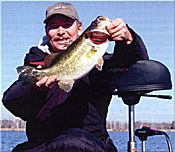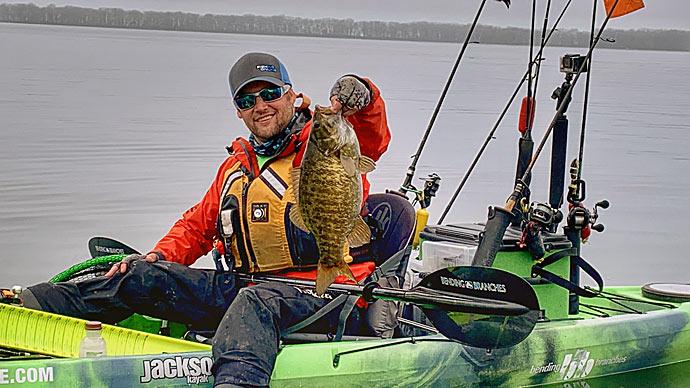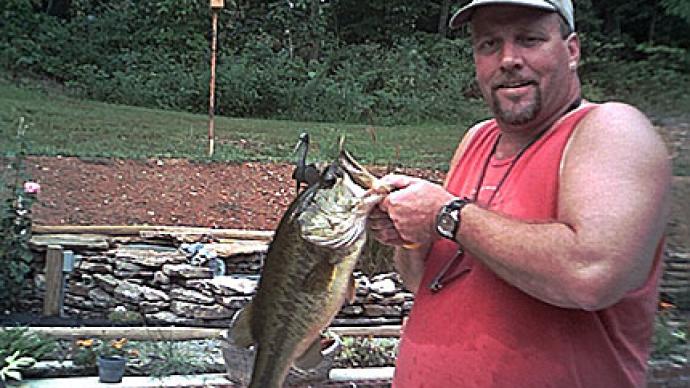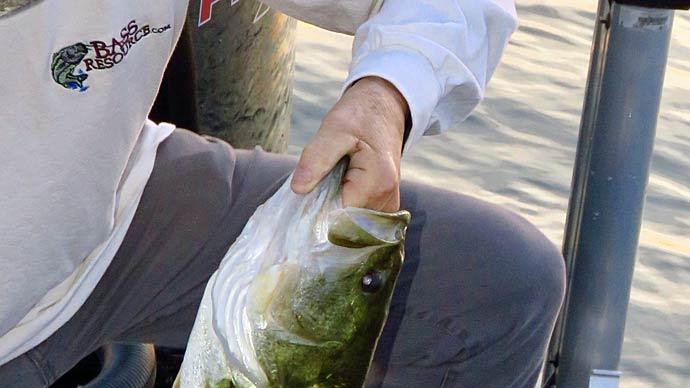
The excitement of a large or small bass blowing up on the water's surface is a thrill few anglers soon forget. With springtime right around the corner, it is time to break out the topwater lures and be on the lake as the sun peeks over the eastern shoreline.
Topwater plugs can be broken into five categories or styles; poppers, darters, prop baits, crawlers, and flexible plastics.
Poppers
There are two basic types of poppers, one pops or chugs, and the other spits.
One of the first widely marketed surface poppers was the Hula Popper. The Hula Popper was designed to imitate a frog, and adding a skirt separated it from most other surface poppers.
The original Hula Poppers were made of wood, like most of the original topwaters. Today only one or two lure companies still make their surface lures out of wood. Virtually all are now molded from hard plastics.
The chugger-style popping plug worked much like the Hula Popper. However, it was designed and colored to imitate an injured fish. Although both the Hula Popper and Chugger would spit water out in front, both made a reasonably loud pop in the process.
The spitting-type surface lure came along in the late 1970s, some 30 years after the Hula Popper and Chugger-type plugs. The Pop-R was among the first spitters. Instead of making a loud pop, the Pop-R would simultaneously pop and spit water several feet in front of the lure.
The shape and angle on the face of these three plugs determined how they functioned and the sound they made on the water's surface. All of these lures came in various sizes, with the 3- to 4-inch and 1/4- to 1/ 2-ounce sizes being the most popular. All three lures are still marketed and avidly fished today.
The Pop-R type lure has been most frequently copied and is used more by modem anglers. Shad or sunfish colors are more popular on the Pop- R, while frog colors are still popular for the Hula Popper.
All the above lures are now marketed with rattles inside the bodies for added attraction. Some of the Pop-R knockoffs made in Japan and other places have specialized paint jobs and special feathers on the rear treble hook and can cost more than $20 each. Light action rod and reel combos are best for presenting and working popping lures. A pistol-gripped rod will save a lot of wear and tear on your wrist. Line weights from 10- to 17-pound tests will perform best.
The lure is cast alongside an object, such as a tree, rock, dock, etc., and allowed to rest for a few seconds. Then using your wrist either sharply or lightly, you "pop" the plug twice. Then you allow the lure to rest for 10 to 30 seconds. This series of jerks is continued about halfway back to the boat.
Old-timers believe you should wait for all the small waves from the lure to subside before starting your action following your cast. This may or may not be true since many of your strikes will occur when the plug is actively popped.
You need to experiment with the degree and intensity of popping needed to attract fish to the lure. On some occasions, one very slight pop may be sufficient. On another occasion, popping the lure back to the boat as fast as possible does the trick.
Bass can be brought up from depths of over 30 feet in clear water from the action of surface poppers.
Bass feeding at the surface are caught most frequently during low-light periods. During the first or last hour of daylight, topwater action can be sensational on some waters. Generally, the clearer the water, the better the topwater action. Also, the quieter the water, the better the topwater action. Boating activity can kill a topwater bite quicker than any other disturbance.
Schooling activity can circumvent the light intensity factor. Anytime you see schooling activity, tie on a shad topwater imitation, and you may be pleasantly surprised at the results.
Darters
Darters are recognized from all other types of surface lures by the absence of any head or tail modification. Instead, most darters look somewhat like a cigar in shape. Their darting action comes from the positioning of the front eye screw. It usually is placed slightly below the front middle of the lure's nose or face.
Most darters sit with the rear of the plug below the surface and the head out of the water. When you snap the rod tip down from a position straight on with the lure, it will dart to one side or the other. An experienced angler can produce an erratic side-to-side action called "walking the dog." This action can be done two or three times, stopped, and repeated to the boat. The walking-the-dog technique effectively entices a bass into striking the lure.
Speed and movement variations can be changed to suit the conditions. For example, the preferred technique may be wild and rather brisk on windy days. On the other hand, a more subtle approach may work best on still days.
The Zara Spook was among the first and is still the most popular lure of this type. The 3- to 5-inch length and 1/2- to 3/4-ounce weight are the most widely used. Typically shad patterns such as chrome/black back, chartreuse/black back, or pearl/green back are the most popular. The finishes on modem darters are almost fish-like in appearance, right down to the gills and scales.
Because most darters are relatively heavy, a medium-action rod in 7 to 7 1/2 feet may perform best for most beginners. However, the walking-the-dog technique is easier to perform once you cast the darter with a lighter action rod (i.e., light action 6 1/2-foot length). Monofilament line in 12- to 17-pound test will work best for this technique.
As with most topwater lures, it is best not to set the hook on the fish until you feel the tug. This delay will result in many more hookups over the years.
Darter-style topwaters have always been big bass producers.
Prop Baits
The most popular topwaters are the prop baits. There are two variations. The first has a single propeller on the rear in front of the back treble hook. This style spits water out to one side or both and generally sits with the back prop end slightly lower in the water than the head. The second style has a prop on both ends of the bait and makes, as would be expected, twice as much commotion on the surface. This style sits flat in the water at all times. Both styles run fairly straight due to the prop. Both can be worked with a continual retrieve or jerked through the water to create as much commotion as wanted in an irregular method or pattern.
One of the original rear prop baits, the Tiny Torpedo, has been catching many fish since the early 1960s. The Torpedo and similar single prop baits are best in the 2- to 3-inch sizes in shad or sunfish colors. However, a clear Tiny Torpedo has been the mainstay for bass fishermen for over 40 years.
Single prop lures are better imitations of shad than double prop styles. The double prop baits have also been around since the late 1950s. The Boy Howdy and Devil's Horse have been widely marketed since the mid- 1950s. Both of these lures were initially made of wood. Various double prop lures, including those above, are made today primarily from hard plastic. The double prop lures seem to be a better sunfish or minnow imitator.
Surface lures with props on both ends come in various colors. However, the sunfish colors, such as chartreuse/green back, seem more compelling.
A light action rod and a 6.3:1 gear ratio reel work best on both prop models. Both models come in very light 1/8-ounce sizes made for ultralight tackle. However, southern bass anglers commonly use the 1/4- to 1/2-ounce sizes.
Crawlers
Crawler-style topwaters are not widely used by southern bass anglers. The Jitterbug is best known for this style of topwater. The 2- to 3-1/2-inch sizes are the most popular in black, frog, or perch colors.
Crawlers are used primarily during late evening or at night. A light or medium action 6- to 6-1/2-foot casting rod and reel combo with 15-pound line will work well on this lure.
The retrieve is simple. You just cast it out and turn the handle slowly or as fast as you desire. Keep your rod tip at about 60 degrees, and do not set the hook until you feel the fish pull against your rod. A bass may hit a Jitterbug two or three times before inhaling it.
Strikes on a black Jitterbug at night can be a fantastic experience.
Flexible Plastics
One additional type of topwater bait is not made of wood or hard plastic. Neither is the material the same soft plastic used in making worms. Instead, it is a thin, durable, flexible plastic. Most manufacturers refer to these lures as soft frogs and rats since the most commonly fished models resemble a frog or rat.
Their lightweight, hollow bodies hold air to float over the thickest of aquatic vegetation without getting entangled. Nearly all models are two to four inches long and rarely weigh more than a 1/4-ounce, even though some manufacturers list them as 1/4- or 1/2- ounce models. Most colors or color combinations have green, chartreuse, or brown backs, with a white or chartreuse belly.
A long shank double hook in 1/0 to 4/0 runs the length of the entire body and is positioned so that the back of the bait guards the point of the two hooks.
Because they are light and awkward to cast, it is best to use a light action 7- to 7-1/2 foot rod. However, you almost need a medium-action rod to get a good hook set. A 6- to 6-1/2-foot medium action spinning rod and reel combo equipped with 20- to 30-pound braided line, with a 7- to 8-foot 20-pound fluorocarbon leader, is very effective.
When you get a strike on a plastic frog, you better not set the hook until you feel a "stick," or you will get what a stakeout victim gets... "all air."
The Scum Frog is a classic lure of this style. Getting four strikes for every bass you catch is not unusual, but it is still great fun, and that's what topwater fishing is all about.
Buzzbaits
Another topwater category that takes a bit more work, as the lure does not generally float, is the buzzbait.
Buzzbaits are similar in physical appearance to spinnerbaits. However, they are built with a blade that resembles a butterfly with its wings outstretched and cupped on the tips.
The number of blades and material the blade is made of can differ somewhat among buzzbaits. However, there are three common blade combinations. The one used most has two blades, while the triple- and quad-wing baits are used less frequently.
Most buzz blades are made of light weight aluminum or Lexan. Two-bladed aluminum buzz blades are the most popular.
Silver or chrome is the most common color. However, black, chartreuse, white, and gold-plated blades have recently gained popularity. Lexan blades are generally black, white, chartreuse, or clear in color. Buzz blades range in size from 1/2-inch in length to up to 3-1/2 inches. Most buzz blades are as wide as they are long.
The buzz blade turns on a wire arm or shaft, similar to a propeller. The buzz blade provides lift, keeping an up to 1/2-ounce lead head on the surface during retrieval.
As the buzzbait is pulled through the water, the blades chop the water's surface and create quite a commotion. A bass sees the blade's action and thinks a larger fish is chasing a smaller fish and often tries to eat both with a single lunge.
There are two basic shapes of buzzbaits: In-line and U-shaped.
In-line
The in-line buzzbait has the blade directly in front of the lead head, just like an in-line spinnerbait. Anglers can keep an in-line buzzer on the surface with much less effort than a U-shaped buzzer of similar weight and blade size. However, the in-line is not as popular with southern bass anglers.
U-Shaped
Most southern anglers have at least one or more U-shaped buzzbaits in their tackle box.
A 1/4- or 1/2-ounce white or chartreuse head and skirt combo with a nickel-plated blade is universally the most popular. Depending on the weight of the buzzbait, a light to medium action 7- to 7-1/2-foot casting rod and 6.3:1 gear ratio reel works best. Some anglers opt for a softer fiberglass rod. Monofilament line from 12- to 17-pound test will do just fine. Braided line is not recommended for buzzbaits.
A buzzbait is the equivalent of a Rat-L-Trap, in that both can work you to death. You cast the buzzbait past your target, hold your rod tip at a 60- to 70-degree angle to the line, and start turning the reel handle. Some days the bass like the bait streaking across the water. On other days they want a slow retrieve.
As with other topwaters, try not to set the hook until you feel a tug at the other end.
Grubs and split-tailed soft plastic trailers work well behind buzzbaits. Either trailer adds lift and bulk to the bait. Trailers may also aid in the amount of time a bass holds a buzzer. Trailer hooks can also be a plus when bass seem to "short-strike" buzzbaits. Usually, they short-strike a lure because it is too large or perhaps the wrong "color." Unless you have a wide assortment of buzzbaits, a trailer hook may be your best choice.
Also, check the hooks on your lures and ensure they are high-quality, sharp hooks. Many anglers have lost a trophy because they trusted old line or dull hooks.
BassResource may receive a portion of revenues if you make a purchase using a link above.




